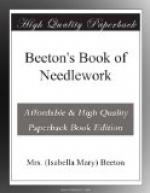[Illustration: 473.—Third mode of making Picots or Dots.]
EDGES AND PURL FINISH.
The correct edging of lace is a most important part of this art, and care should be taken to work a proper edge for each kind of lace. Sorrento edging should be worked upon Limoges lace. Spanish lace requires a full rich edge, as shown in No. 478, &c. The simplest edge is point de Bruxelles, which is worked somewhat like the stitch No. 433, and is secured by a knot worked in the braid. Many lace-workers omit this knot.
[Illustration: 474.—Point de Bruxelles Edging.]
No. 475.—SORRENTO EDGING is worked with one short and one long stitch alternately.
[Illustration: 475.—Sorrento Edging.]
No. 476.—POINT DE VENISE is worked precisely like that stitch (see page 456), three and even four stitches being worked in the loop.
[Illustration: 476.—Point de Venise Edging.]
No. 477.—POINT D’ANGLETERRE EDGING is worked in point de Bruxelles, the thread being again drawn through the braid before proceeding to the next stitch. This edging is strong and useful.
[Illustration: 477.—Point d’Angleterre Edging.]
No. 478.—POINT D’ESPAGNE EDGING.—This stitch is easily worked. Insert the point of the needle through the braid and wind the thread round it 20 times, draw the needle through these windings and draw the picot tight, sew over the braid the space of 3 stitches, and repeat.
[Illustration: 478.—Point d’Espagne Edging.]
No. 479.—ANTWERP EDGE.—This edge is only a variety of point d’Angleterre edging, and differs only in the mode of making the knot; the thread is passed over, under, and through the loop formed by the point de Bruxelles lace.
[Illustration: 479.—Antwerp Edge.]
NOTE.—It will be observed that the stitches here given are much enlarged for the sake of clearness in showing details.
PATTERNS.
No. 480.—Star in Point Lace.
Materials: Braid; Messrs. Walter Evans and Co.’s Mecklenburg thread No. 20.
Trace the outline upon paper or leather, lay the braid on as directed. Work the centre in Sorrento bars, and on these work a rosette in point d’Angleterre, the edge in point d’Angleterre edging, and the wheels in open English lace.
[Illustration: 480.—Star in Point Lace.]
* * * * *
No. 481.—Medallion in Point Lace.
Materials: Linen Braid; Messrs. Walter Evans and Co.’s Mecklenburg thread No. 14.
This medallion is useful for cravat ends and for a number of purposes, as trimming for sachets, dresses, &c. Having placed the braid as before directed, work an English rosette in the centre, fill in the ground with point de fillet or with point de Bruxelles. An edging of Spanish point completes this pretty medallion.




